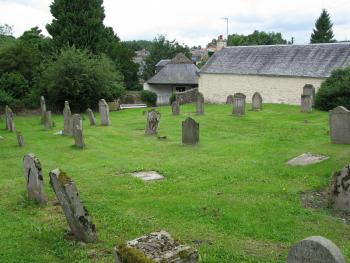- Navigation:
- Back to the Corpus index page
- RSS
Pitcairn Parish Church
Pitcairn, churchyard at Almondbank
- Dedication: St Serf
- Diocese of Dunkeld
- Deanery of Fife and Strathearn
- County of Perthshire
- Perth and Kinross Council
- NO 0652 2961 ?
Summary description
The site of the medieval parish church is thought to have been within the graveyard at Almondbank. Nothing remains of any church there.
Historical outline
Dedication: St Serf
Very little is known about this church which may have been the original mother-church of a large parish encompassing both Pitcairn north of the River Almond and Tibbermore to its south. According to Alexander Myln, writing in the early 1500s, Bishop George Brown (1483-1515) ‘restored and built up’ the church of St Serf, which had once been the ‘principal church of the parish’. He recounted what he described as an old tale that it had fallen into disfavour and neglect on account of the accidental drowning of an infant son of Lord Ruthven, who had fallen into the river when the family had been returning to Huntingtower after his baptism in the church. Its role as parish church had then been taken over by the church of St Mary at Tibbermore, which Myln states had originated as an oratory attached to the bishop of Dunkeld’s residence there.(1)
Pitcairn is not listed in Bagimond’s Roll but a vicarage of Tibbermore is.(2) It is possible that the church of Pitcairn had been annexed fully to the episcopal mensa from the early thirteenth century. A separate parish of Pitcairn is recorded in 1505-6 in the rental of the bishopric of Dunkeld, apparently confirming the suggestion of its early annexation to the mensa, a union further supported by reference to the lands of Pitcairn as the lordship of the same in the bishop’s estates in 1509.(3) The restoration effected by Bishop Brown appears also to have included the establishment of a vicarage perpetual. Sir Simon Young, vicar of Pitcairn and dean of Christianity of Gowrie, is on record in February 1532/3, and in August 1549 sir John Beir was presented to the vicarage.(4)
Notes
Architectural description
The present church of the parish, at Almondbank, was built for a United Free congregation to the designs of Hippolyte Blanc in 1904-5, and the absence of burials around it confirms that it is on a modern site. The location of the medieval church is thought to have been about 100 metres to its south, on the north bank of the River Almond, where there is a small graveyard, though none of the visible memorials there appears to be earlier than the nineteenth century, and there is no evidence of any church building.
Bibliography
Cowan, I.B., 1967, The parishes of medieval Scotland, (Scottish Record Society), Edinburgh, 165.
Dunlop, A.I., 1939, ‘Bagimond’s Roll, statement of the tenths of the kingdom of Scotland’ Miscellany of the Scottish History Society, vi, 1-77, at 48, 72.
Gifford, J., 2007, The Buildings of Scotland, Perth and Kinross, New Haven and London, 149.
Registrum Magni Sigilli Regum Scottorum, 1883, Edinburgh, iii (1513-46), no 1341.
Registrum Secreti Sigilli Regum Scotorum, 1908-82, ed. J.M. Thomson et al., Edinburgh, iv, no 386.
Rentale Dunkeldense, 1915, ed. R.K. Hannay, (Scottish History Society), Edinburgh, 53, 195-6.
Royal Commission on the Ancient and Historical Monuments of Scotland, Canmore database.
Vitae Dunkeldensis Ecclesiae Episcoporum...Ad Annum Mdxv, 1823, ed. T. Thomson, (Bannatyne Club), Edinburgh, 44.
Map
Images
Click on any thumbnail to open the image gallery and slideshow.




